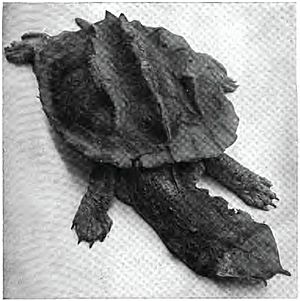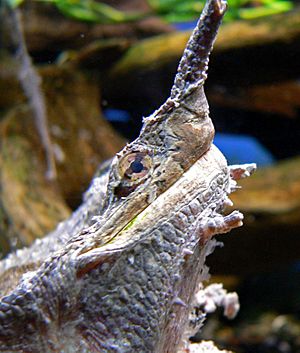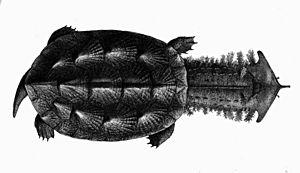Mata mata facts for kids
Quick facts for kids Mata mata |
|
|---|---|
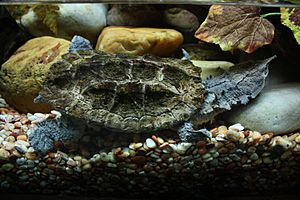 |
|
| Shanghai Aquarium | |
| Conservation status | |
| Scientific classification | |
| Genus: |
Chelus
|
| Species: |
fimbriata
|
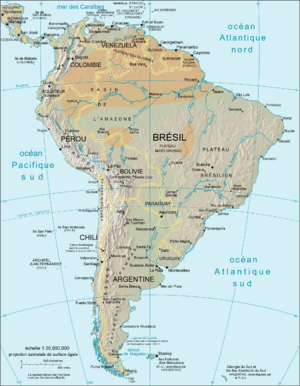 |
|
| Mata mata distribution | |
| Synonyms | |
|
Species synonymy
|
|
The mata mata (Chelus fimbriata) is a unique freshwater turtle found in South America. It mainly lives in the Amazon and Orinoco river areas. This turtle is one of two living species in its genus Chelus. The other species is called Chelus orinocensis.
Contents
About the Mata Mata Turtle
The mata mata turtle was first described in 1741 by a French naturalist named Pierre Barrère. He called it a "large land turtle with spiky and ridged scales." Later, in 1783, a German naturalist, Johann Gottlob Schneider, gave it the scientific name Testudo fimbriata.
Over the next 200 years, this turtle's name was changed 14 different times! Finally, in 1992, it was named Chelus fimbriata.
Two Types of Mata Mata?
Scientists noticed that mata mata turtles from the Amazon and Orinoco rivers looked a bit different. In 2020, a special DNA study showed a big difference between these two groups. Because of this, scientists suggested that the turtles from the Orinoco river should be a new species, Chelus orinocensis. The turtles from the Amazon river kept the name Chelus fimbriata.
What Does a Mata Mata Look Like?
The mata mata is a large turtle that doesn't move around much. It has a very flat, triangular head with many bumps and skin flaps. It also has a long, tube-like nose that looks like a "spike."
It has three small whiskers, called barbels, on its chin. Four more thin whiskers are on its upper jaw. Its mouth is not hooked or notched.
Shell and Body
The mata mata's top shell, called a carapace, is brown or black and can grow up to 95 centimeters (about 37 inches) long. An adult turtle can weigh up to 21 kilograms (about 46 pounds).
Its bottom shell, called a plastron, is small and narrow. It doesn't have a hinge and is deeply notched at the back. These features might help the turtle look like a piece of bark, helping it hide from animals that might want to eat it. The plastron is usually cream, yellow, or brown.
The head, neck, tail, and legs of adult mata matas are grayish-brown. The neck is longer than the part of its spine under its shell. It has small skin flaps along both sides. Baby mata matas have a pink or reddish color on the underside of their shells, which fades as they grow.
Each front foot has five webbed claws. Male mata matas have a curved-in bottom shell and longer, thicker tails than females.
Where Do Mata Matas Live?
Mata matas live in slow-moving, dark-colored streams, still pools, marshes, and swamps. You can find them in northern Bolivia, eastern Peru, Ecuador, eastern Colombia, Venezuela, the Guianas, and northern and central Brazil.
These turtles always stay in the water. They prefer shallow water where they can easily reach their long noses to the surface to breathe.
Mata Mata Behavior
The mata mata's shell looks like tree bark, and its head looks like fallen leaves. This helps it blend in perfectly with its surroundings. It stays very still in the water, and its skin flaps help it disappear into the plants around it.
When a fish swims close, the mata mata quickly thrusts its head out and opens its large mouth wide. This creates a vacuum that sucks the prey right into its mouth! This is called suction feeding. The mata mata then snaps its mouth shut, slowly pushes the water out, and swallows the fish whole. It cannot chew because of how its mouth is made.
Reproduction and Life Cycle
Male mata matas try to attract females by stretching out their legs. They lunge their heads toward the females with their mouths open and move the flaps on the sides of their heads.
Nesting happens from October to December in the Upper Amazon region. A female turtle lays between 12 and 28 eggs in one group. The eggs are round, brittle, and about 35 millimeters (1.4 inches) across.
What Do Mata Matas Eat?
Mata matas are carnivores, meaning they eat meat. They mostly eat small water animals like worms, mussels, crustaceans (like crabs), and insects. They also eat fish. Very rarely, they might eat small birds, amphibians, or tiny mammals that fall into the water.
Scientists looked at the stomach contents of 20 wild mata mata turtles and found only small fish. These turtles mostly hunt at night in muddy water where it's hard to see. But the mata mata is very good at hunting in these conditions. It has excellent eyesight, and its eyes reflect light, like other animals that are active at night. Also, the skin flaps on its neck are super sensitive and help it feel any movement nearby.
Mata matas have a special way of catching their food. They will guide their prey into shallower water. Then, they surround the prey and wave their front legs to stop the prey from escaping. Once the prey is trapped, the mata mata opens its mouth and sucks the water in, pulling the prey into its mouth.
Mata Matas as Pets

Mata mata turtles are popular in the exotic pet trade, but they can be quite expensive. Their unique look makes them interesting display animals. They also grow quite large. However, mata matas are not very active hunters, so they don't need as much space as a very active turtle species.
Keeping these turtles healthy in captivity means having good water quality. Warm, slightly acidic water with a lot of tannin (which makes the water look tea-colored) is best. This water should be kept clean all year round, so good filtration is important. Some people who own mata matas, like author David Fogel, believe these turtles are quite intelligent. For example, he saw one of his turtles position itself near the aquarium's water spray bar at feeding time. This way, the floating food was pushed underwater, making it easier for the turtle to catch.
See also
 In Spanish: Matamata para niños
In Spanish: Matamata para niños



